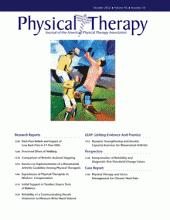Abstract
Background Robotic-assisted locomotor training has demonstrated some efficacy in individuals with neurological injury and is slowly gaining clinical acceptance. Both exoskeletal devices, which control individual joint movements, and elliptical devices, which control endpoint trajectories, have been utilized with specific patient populations and are available commercially. No studies have directly compared training efficacy or patient performance during stepping between devices.
Objective The purpose of this study was to evaluate kinematic, electromyographic (EMG), and metabolic responses during elliptical- and exoskeletal-assisted stepping in individuals with incomplete spinal cord injury (SCI) compared with therapist-assisted stepping.
Design A prospective, cross-sectional, repeated-measures design was used.
Methods Participants with incomplete SCI (n=11) performed 3 separate bouts of exoskeletal-, elliptical-, or therapist-assisted stepping. Unilateral hip and knee sagittal-plane kinematics, lower-limb EMG recordings, and oxygen consumption were compared across stepping conditions and with control participants (n=10) during treadmill stepping.
Results Exoskeletal stepping kinematics closely approximated normal gait patterns, whereas significantly greater hip and knee flexion postures were observed during elliptical-assisted stepping. Measures of kinematic variability indicated consistent patterns in control participants and during exoskeletal-assisted stepping, whereas therapist- and elliptical-assisted stepping kinematics were more variable. Despite specific differences, EMG patterns generally were similar across stepping conditions in the participants with SCI. In contrast, oxygen consumption was consistently greater during therapist-assisted stepping.
Limitations Limitations included a small sample size, lack of ability to evaluate kinetics during stepping, unilateral EMG recordings, and sagittal-plane kinematics.
Conclusions Despite specific differences in kinematics and EMG activity, metabolic activity was similar during stepping in each robotic device. Understanding potential differences and similarities in stepping performance with robotic assistance may be important in delivery of repeated locomotor training using robotic or therapist assistance and for consumers of robotic devices.
Footnotes
Dr Hornby, Ms Kinnaird, and Ms Rodriguez provided concept/idea/research design. Dr Hornby, Ms Kinnaird, and Ms Cain provided writing. Dr Hornby, Ms Kinnaird, Ms Holleran, Ms Rafferty, and Ms Rodriguez provided data collection and analysis. Dr Hornby, Ms Kinnaird, and Ms Rafferty provided project management. Dr Hornby provided fund procurement, facilities/equipment, and institutional liaisons. Ms Rodriguez provided study participants. Ms Kinnaird provided clerical support. Ms Kinnaird, Ms Holleran, and Ms Rodriguez provided consultation (including review of manuscript before submission).
This study was approved by the Institutional Review Board of Northwestern University.
The study was funded by the National Institute of Disability and Rehabilitation Research (H133N060014).
- Received September 18, 2011.
- Accepted June 5, 2012.












